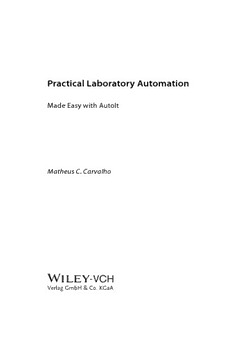Table Of ContentPractical Laboratory Automation
MadeEasywithAutoIt
MatheusC.Carvalho
Dr.MatheusC.Carvalho
SouthernCrossUniversity
CentreforCoastalBiogeochemistryRes.
POBox157,Lismore,NSW,2480
2480Lismore
Australia
©2017Wiley-VCHVerlagGmbH&Co.KGaA,
Boschstr.12,69469Weinheim,Germany
PrintISBN:978-3-527-34158-0
ePDFISBN:978-3-527-80198-5
ePubISBN:978-3-527-80196-1
MobiISBN:978-3-527-80197-8
oBookISBN:978-3-527-80195-4
Contents
Foreword xiii
Preface xv
1 Introduction 1
1.1 ABriefStoryofLaboratoryAutomation 1
1.2 ApproachesforInstrumentIntegration 2
1.2.1 TheUsualApproachforInstrumentIntegration 2
1.2.2 InstrumentIntegrationwithScripting 3
1.3 ScriptingversusStandardizationinLaboratoryAutomation 3
1.4 TopicsCoveredinthisBook 5
1.5 LearningbyDoing:FACACOandFAKAS 7
1.6 Summary 10
SuggestedReading 10
2 TheVeryBasicsofAutoIt 13
2.1 WhatIsAutoIt? 13
2.2 AlternativestoAutoIt 14
2.3 GettingAutoIt 15
2.4 WritingYourFirstScript(MouseClickAutomation) 15
2.5 KnowingMoreaboutSciTE 16
2.5.1 WritingAids 17
2.5.2 TheConsole 18
2.6 AutoItonLinux 18
2.7 Summary 18
SuggestedReading 19
3 TimedScripts 21
3.1 ControllingtheTimingofActions 21
3.2 MovingandActivatingWindows 22
3.3 SendingKeyboardInputs 23
3.4 “For”LoopsandVariables 23
3.4.1 AutomatingFAKAS 25
3.4.2 FirstviewofAutoItv3WindowsInfo(AWI) 26
3.4.3 AU3Recorder 28
3.4.4 AutomatingFACACO 29
3.5 OrganizingYourCode:FunctionsandLibraries 29
3.5.1 CallingFunctionsfromDifferentFiles 31
3.6 ReplacingMouseClickswithKeyboardShortcuts 32
3.7 Summary 34
4 InteractiveScripting 35
4.1 WindowMonitoring 35
4.2 PixelMonitoring 37
4.3 “While…WEnd”LoopsforPixelMonitoring 39
4.4 SynchronizingFACACOandKAKASUsingPixelMonitoring 40
4.5 EnhancedPixelMonitoringUsingPixelCheckSum 43
4.6 BlockingAccesstoKeyboardandMouse 46
4.7 Summary 46
5 ScriptingwithControls 49
5.1 UsingAWItoGetControlInformation 49
5.2 FunctionsThatProvideControlInformation 51
5.3 SendingCommandstoControls 52
5.4 SynchronizingFACACOandFAKASUsingControls 52
5.5 DealingwithErrors:If…Then 55
5.6 InfiniteLoopsandControls 57
5.7 Summary 59
6 E-mailandPhoneAlarms 61
6.1 E-mailAlarms 61
6.1.1 SendingE-mailUsingThird-PartySoftware 61
6.1.2 SendingE-mailUsingSMTP 63
6.2 SMSandPhoneCallAlarms 65
6.2.1 SendingSMS 65
6.2.2 MakingPhoneCalls 66
6.3 Summary 69
7 UsingLow-CostEquipmentforLaboratoryAutomation 71
7.1 G-CodeDevices 71
7.1.1 CNCRouters 71
7.1.2 G-CodeforCNC 73
7.1.3 SynchronizingaCNCRoutertoaLaboratoryInstrument 74
7.1.4 3DPrinters 75
7.2 RoboticArms 76
7.3 Do-It-YourselfDevices 77
7.4 Summary 77
SuggestedReading 78
8 ArraysandStrings 79
8.1 OrganizedData:Arrays 79
8.2 RawData:Strings 80
8.3 Summary 82
9 DataProcessingwithSpreadsheets 83
9.1 ExportingResultstoSpreadsheetSoftware 83
9.1.1 SelectingSpreadsheetSoftware 83
9.1.2 TransferringDatatoSpreadsheets 84
9.1.3 TransferringDatainRealTime 87
9.2 DealingwithSavedResults(Files) 87
9.3 ProcessingSpreadsheetFiles 91
9.4 Summary 94
10 WorkingwithDatabases 95
10.1 StartingSQliteinAutoIt 95
10.2 CreatingSQliteDatabases 96
10.3 ModifyinganExistingSQliteDatabase 99
10.4 DatabaseswithMoreThanOneTable 101
10.5 RetrievingDatafromDatabases 102
10.6 Summary 104
11 SimpleRemoteSynchronization 107
11.1 TimeMacros 107
11.2 SynchronizingFACACOandFAKASUsing
TimeMacros 108
11.3 Summary 109
12 RemoteSynchronizationUsingRemoteControlSoftware 111
12.1 TeamViewer 111
12.2 SynchronizingFACACOandFAKASUsing
TeamViewer 112
12.3 Summary 115
13 Text-BasedRemoteSynchronization 117
13.1 ChoosingInstantMessagingSoftware 117
13.2 WritingandReadingfromTrillianUsingAutoIt 119
13.3 SynchronizingFACACOandFAKASUsingTrillian 121
13.4 Summary 123
14 RemoteSynchronizationUsingIRC 125
14.1 AutoItandIRC 125
14.2 MonitoringtheConnection 126
14.3 SynchronizingFACACOandFAKAS 130
14.4 FinalConsiderations 132
14.5 Summary 133
15 RemoteSynchronizationUsingWindowsLANTools 135
15.1 ConnectingtoaLAN 135
15.2 CreatingaSharedFolder 137
15.3 SynchronizingFACACOandFAKAS 139
15.4 Summary 140
16 RemoteSynchronizationUsingThird-PartyLANSoftware 143
16.1 ConnectingtoaLANUsingBingo’sChat 143
16.2 AutomatedCommunicationUsingBingo’sChat 144
16.3 SynchronizingFACACOandFAKAS 147
16.4 Summary 148
17 InteractingwithDevicesviaCOMPorts 149
17.1 SerialCommunicationProtocols 149
17.2 AutoItandCOMPorts 150
17.3 MonitoringinRealTime 153
17.4 ImplicationsforOtherDevices 157
17.5 OtherTechnologiesforInstrumentControl 157
17.6 Summary 157
SuggestedReading 158
18 IntroductiontoGraphicalUserInterface(GUI) 159
18.1 MakingaVerySimpleGUI 159
18.2 AddingSimpleElementstoaGUI 161
18.3 SettingKeyboardShortcuts 163
18.4 Summary 165
19 UsingGUItoControlInstruments 167
19.1 GUIstoControltheEHMAValveActuator 167
19.2 ControllingTwoorMoreCOMPortsintheSameScript 169
19.3 AGUItoControlaDigitalBalance 171
19.4 Summary 174
20 MultitaskingGUIs 177
20.1 The“GUIOnEventMode”Option 177
20.2 MultitaskingUsingGUIOnEventMode 179
20.3 Summary 182
21 AddingGraphicalElementstoaGUI 183
21.1 GettingStartedwithGDIplus 183
21.2 CreatingAnimationsUsingGDIplus 185
21.3 Summary 189
22 CreatingGUIsUsingKoda 191
22.1 GettingStartedwithKoda 191
22.2 CreatingaScript 194
22.3 Summary 196
23 SomeSuggestions 197
23.1 ForManufacturers:AllInstrumentswithaGUI 197
23.2 ForManufacturers:AllGUIswithAccesstoControls 197
23.3 ForManufacturers:StopDevelopingStandardsforLaboratory
Automation 197
23.4 ForUsers:HardwareTrumpsSoftware 198
23.5 ForUsers:IfYouCan,ChooseControls 198
23.6 ForUsers:AutoItMayNotbetheBestProgrammingOption
inSomeCases 198
23.7 ForUsers:BeAwareofTechnologicalAdvances 199
23.8 ForUsersandManufacturers:AutoItScriptsMayServeas
BasisforNewProducts 199
SuggestedReading 199
A OtherSciTEFeatures 201
A.1 CodeWizard 201
A.2 OrganizingYourScriptswithTidy 202
A.3 ToolsthatFacilitateNavigation 203
B OpticalCharacterRecognition 207
B.1 OCRinAutoIt 207
B.2 CopyingfromtheScreenandApplyingOCR 209
C ScriptingwithNonstandardControls(UIA) 211
C.1 DownloadingtheUIASoftwarePackage 211
C.2 SendingInstructions 212
C.2.1 MouseClicks 213
C.2.2 KeyboardInputs 216
C.3 GettingInformationaboutControls 217
C.3.1 GettingInformationfromFAKASControls 218
C.3.2 GettingInformationfromControlsofOtherPrograms 220
C.4 AutomatingaLabViewProgram 221
C.5 Summary 222
Index 223
Foreword
Wouldyouliketohavealabassistantwillingtodothemosttediousrepetitivetasksin
yourlaboratoryperfectlyeverytime?Wouldyoulikethatlabassistanttoworkforafew
centsanhourfor24haday,7daysaweek,365daysayear?Betteryet,wouldyoulikethe
salaryofthatlabassistantcoveredundertheoperationaloverheadofyourinstitution?
Thisisallmorethanpossiblewiththelaboratoryautomationwizardryexplainedin
detailbyMatheusCarvalhointhisbook.PracticalLaboratoryAutomation–MadeEasy
withAutoItisatourdeforceinlaboratoryautomation.Itallowsscientiststoharness
automationtoradicallyincreaseproductivityasiscommoninindustry.Specifically,Car-
valhoguideseventhemostinexperienceduserintoadeepdiveofAutoItinthecontextof
laboratoryautomation.AutoItisazero-costsoftwaretoolthatautomatesmouseclicks
and keyboard entries in Windows. These properties enable seamless integration into
theoperationofotherprograms–liketheshockinglyexpensiveproprietaryprograms
thatcomebundledwithmostconventionalmodernscientificequipment.AutoItsource
codewasopenlyreleasedundertheGNUGPL(uptov.3.22006),andthenwentontwo
paths.TheAutoHotkeyprojectremainsopensourceandAutoItbecameclosedsource,
butremainsfreewarewithasupportiveonlinecommunity.
MyownintroductiontoAutoItcameseveralyearsagowhenweneededtomakethe
same measurement in my laboratory every few minutes for hundreds of hours con-
tinuously. This was a waste of time for even the least-skilled and poorly paid student
researcher. The obvious solution was to add a single loop to the equipment vendor’s
proprietarysoftwarerunningthetooltomakethemeasurements.Thevendortriedto
extortthousandsofdollarsfromustoincludethisnewfunctionality.Unfortunatelyfor
the vendor, a student found AutoIt. Our problem was solved in seconds. Now a few
penniesofelectricitywouldenabletheworstmeasurementinmylaboratorytobecom-
pletedwithoutanywastedstudenthour.BesidesteachingmethevalueofAutoIt,this
experiencesetmeonthepathoffirstmakingourownscientifictoolsandeventuallyinto
theopen-sourcescientifichardwarecommunity.Thishassavedmylaboratoryhundreds
ofthousandsofdollarsandPracticalLaboratoryAutomationmaydothesameforyou.
Now our initial use of AutoIt is trivial compared to the super user abilities that
Carvalho demonstrates throughout this book. This is a book you should read with a
computer on your lap so that you can ensure you learn the skills by trying them out
as Carvalho explains new techniques. You will walk away after reading it with the
technicalskillstoautomateeventhemostcomplexscientificequipment.Ishouldpoint
out that although the techniques Carvalho explains in this book are complex (e.g.,
pixel monitoring, scripting, and remote synchronization) this book is written for the
nonspecialist Windows user. It really has been “made easy.” Anyone who works in a
laboratory–evenifhe/shedoesnotknowanythingaboutcoding,robotics,embedded
systems, or microcontrollers will have no problem using the techniques discussed
to automate his/her own equipment. As Practical Laboratory Automation correctly
pointsout,thiswillenableyoufreedomfromlock-inwiththeequipmentvendorsusing
Windows as the platform of their machine, which alone should save you money and
helpyourlabfunctionmoreefficiently.Italsooffersthepotentialto“resurrect”formally
quasi-functional tools collecting dust in the corner of your laboratory now (such as
thosewherethesoftwareisnolongersupported).However,evenmoreexcitingisthe
opportunitiesthisbookgivesyoutouseautomationtotacklenewtypesofexperiments
that would simply have been too time-consuming or cost-prohibitive for all but the
mostwealthylaboratories.
Youhavemadeagooddecisiontopurchasethisbook.Itwillmakeyourlaboratory
more efficient and save you money. My hope is that it functions as a good “gateway”
drugthatitpullsyouintoopen-sourcescientifichardwarecommunity.Thiscommunity
isbuildingfromscratchprogressivelymoresophisticatedautomatedresearchtoolsfor
atinyfractionofthecostofproprietaryequipment.Boththesourcecodeforthehard-
ware andthe software are being shared openly enablingrapiddiffusion andtechnical
evolution.Asyoubecomefamiliarwithautomationandcomfortablewiththeabilityto
improvethefunctionalityofyourequipment,thetechnicaljumptohackingopenhard-
ware becomes far less intimidating. So, fire up your computer, turn the page, and get
started.
JoshuaPearce
MichiganTechOpenSustainabilityTechnologyLab
Open-SourceLab:HowtoBuildYourOwnHardwareandReduceResearchCosts
Houghton,MI
Preface
Someyearsago,Ifoundbychanceaverycheaproboticarm(∼US$100)forsale.This
roboticarmcouldbecontrolledusingacomputer,similarlytoautosamplersofanalyt-
icalequipment.Adevicewiththatcapabilityandcostingsolittlewasasurprisetome,
becauseIwasusedtoautosamplerscostingasmuchasabrandnewcar.Atthatpoint,
I was familiar with AutoIt, the scripting language presented in this book, and I real-
ized that using it I could try to use the robotic arm as a substitute for the expensive
autosamplers.Ididit,anditworkedperfectly.
The test with the robotic arm made clear for me that AutoIt could be used to inte-
grate any type of devices in the laboratory, enabling not only money saving, but also
totalfreedomregardingthechoice ofequipment.AsIcametorealize,mycolleagues
werenotawareofsuchpossibilities.Therefore,Idecidedtosharethisideawithother
professionals,andpublishedtwoarticlesinscientificjournalsaboutAutoItusedinthe
contextoflaboratoryautomation.However,scientificarticlesareshort,notallowingfor
anin-depthcoverageofAutoIt,andthusIdecidedthatabookwouldbeabetterwayto
disseminatetheideaamonglaboratorytechniciansandscientists.
ThisbookcoversseveralaspectsofAutoItinthecontextoflaboratoryautomation.I
expectittoempowerreadersintwoways:
1) Byprovidingindependencefrominstrumentmanufacturers.InthesamewayIcould
use a cheap robotic arm as an autosampler for analytical equipment, readers will
becomeabletocombineanytypeofequipmentveryeasily.Doingso,itwillbepossi-
bleforthemtochoosethedevicethatisthebestorthemostcosteffectiveforagiven
task, regardless of what manufacturers could have originally suggested. If you are
familiarwiththefieldoflaboratoryautomation,thismaycomeasasurprise.Nowa-
days,theprevalentviewisthatintegrationoflaboratoryequipmentisverycomplex
and accessible only for specialized professionals. This book will demonstrate that
withAutoItsuchintegrationisverysimpleandaccessibletovirtuallyanylaboratory
technicianorscientist.
2) BypresentingAutoIt.AutoItisnotjustanotherscriptinglanguage.Becauseitauto-
matesmouseclicksandkeyboardentries,AutoItisaverypowerfultoolthatallows
completeautomationofaprogram,andalsototalintegrationamongdifferentpro-
grams.Beingfreetogetandeasytolearn,AutoItisafantastictoolthatcanbeused
notonlyinthecontextoflaboratoryautomation,butalsoasageneralwaytoeasily
increaseproductivitywhenusingthecomputer.

